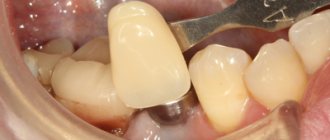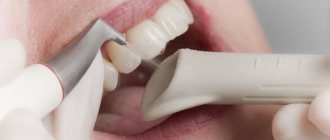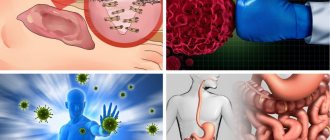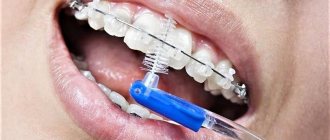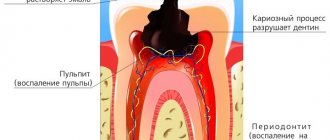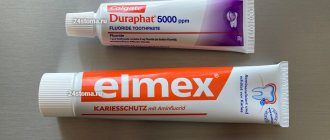Anatomical features of abutment teeth
Chewing force is the physiological pressure exerted by the muscles of the mandibular structure. Abutment teeth play an important role in this process, helping to crush food and form a partially chemically processed food bolus for later ingestion.
To assess chewing efficiency, the strength and anatomical structure of all elements of the jaw structure are of great importance. The force of physiological pressure is taken to be the compression power of the weakest of the supporting teeth.
This value is determined based on the following features of the morphological structure:
- chewing surface area;
- number of roots;
- degree of tuberosity;
- the interval between the supporting tooth and the angle of the mandibular bone;
- functional state of the periodontium - a complex of soft tissues surrounding the dentin that hold the incisor in the alveolar bed;
- transverse canals of the cervix.
Abutment teeth are used to secure dentures when restoring chewing function using an artificial structure. They are selected based on the results of a comprehensive diagnostic examination.
The dentist studies the type and characteristics of the bite, the relationship of the proposed supporting tooth with neighboring ones, and the general condition of the periodontal tissues. The prosthetist evaluates the mobility and strength of the dentin element. What matters is the proportion between the length of the root of the abutment tooth and the size of the crown being installed.
Chewing efficiency according to Agapov is the volume of crushed food over a certain period of time. This factor is important when choosing pillar elements for installing a bridge structure. Formula for the sum of the coefficients for each side of the jaw apparatus: 0+5+6+4+4+3+1+2 = 25%
Methods for determining effectiveness
Over a certain period of time, the dental apparatus grinds food to the required consistency. To study its function and identify violations, tests for determining chewing efficiency (MEC) are used.
According to Christiansen
The first method for studying PVCs was developed and conducted by Christiansen in 1923. To study the effectiveness:
- the patient is given to chew 3 identical cylinders cut from a coconut;
- the patient makes 50 chewing movements;
- spits crushed nuts into the tray;
- the resulting food bolus is washed and dried at a temperature of 100 ° C.
To determine the fatty acids, the dried nut remains are sifted through a sieve. Conclusions are drawn based on the amount of nut remaining in the sieve.
Disadvantages: too hard food, effectiveness is not studied over time.
Gelman's test
It is an improved Christiansen technique. Developed by Gelman in 1932. Technique:
- the chewing procedure lasts 50 seconds;
- instead of coconut, the patient is given 5 g of almonds;
- the crushed remains are spat out into the cup after 50 s;
- the patient rinses his mouth with boiled water;
- add 8-10 drops of 5% sulima to a cup with chewed almonds;
- the mixture is filtered through cheesecloth
- all residues are dried and passed through a sieve with holes 2.4 mm in diameter.
The technique is based on the fact that in 50 seconds, a person without pathologies of the dental system, with intact dentition, completely chews 5 g of almonds. The entire mass passes through a sieve with 2.4 mm cells. ZhE=100%.
If crushed almonds remain in the sieve, the remainder is weighed (accurate to the hundredth of a gram). The resulting mass is converted into a percentage of the total mass of almonds (5g).
The disadvantage is that it is necessary to chew a large amount of food, which causes discomfort for the patient and leads to errors.
According to Rubinov
The physiological method of I. S. Rubinov was proposed in 1957. Its features:
- the chewing process lasts until the swallowing reflex appears;
- the patient is given 0.8 g of hazelnut to chew (0.5 g of crackers, 1 g of soft bread);
- crushed on one side;
- take into account the time before swallowing food;
- The subject spits out the chewed food into a cup;
- the residues are washed, dried, and passed through a sieve with 2.4 mm holes.
The test allows you to evaluate chewing efficiency by the mass of the residue and the time before swallowing food. Normally, a person with healthy teeth chews a hazelnut in 14 seconds and a cracker in 8 seconds.
Advantages of the sample:
- the condition of individual groups of teeth is assessed;
- the time of chewing food is determined;
- the volume of food used is close to the natural stimulus;
- if chewing is difficult, replace the nuts with soft bread.
The swallowing reflex is influenced by saliva. After taking atropine, which causes dry mouth, chewing time lengthens and the size of swallowed food increases significantly.
According to O. M. Ryakhovsky
Ryakhovsky O. M., Solovyov M. M., Vinogradov S. I. modernized the tests for assessing the vital signs and developed a methodology. Take into account:
- chewing duration is 20 movements;
- masticatory forces (strength of the masticatory muscles on the side being tested);
- volume of test products;
- energy consumption of the muscles involved in the act of chewing.
Use 2 cylinders (diameter – 16 mm, volume – 4.2 cm3). Made from 20% gelatin cured in formaldehyde. To assess PVCs, mathematical analysis is used. Bond's law determines the volume of the remainder.
The chewed material is washed with a stream of water through sieves with holes of different diameters, gradually decreasing from 14 mm to 0.25 mm. Not used in everyday practice.
It requires high-tech equipment (complex hinge systems and devices for mandibular kinesiography, condylography). The technique is labor-intensive and expensive.
Let's figure out why and what to do if your jaw clicks when chewing, is it possible to fix the problem yourself.
This publication is all about correcting a small lower jaw in adults.
Here https://orto-info.ru/zubocheliustnye-anomalii/chelyustey/mandibuloplastiki.html you will find objective reviews about mandibuloplasty.
Requirements for abutment teeth
Such units must meet several criteria.
Key Requirements:
- intact (undamaged and uninfected) periodontal tissues;
- sufficient area and height for installing a clinical crown;
- proper occlusive properties;
- location at a short distance from the defect being corrected.
- healthy tissues of the tooth chosen as the supporting one;
- integrity of the enamel coating.
These requirements are almost never fully met.
Usually, teeth that require dental intervention or have already been treated are located near the defective area of the jaw apparatus. When choosing support units, take into account the high mechanical stress created by the prosthetic structure on the periodontal tissue and bone fibers of the tooth. This increases the risk of developing a pathological process and increases the frequency of exacerbations of chronic dental diseases.
Installation of the bridge structure on the selected supports is carried out only after a detailed diagnostic examination and elimination of all defects that can be treated. Compliance with the requirements for the supporting teeth ensures proper functionality of the prosthesis.
Patients seeking dental care have virtually no ideal conditions for crown placement. It is permissible to use teeth with caries as supports after carrying out the necessary therapeutic procedures.
Inflammation of the pulp is eliminated by obturation (clogging) of the canals with filling material. Teeth with chronic periodontitis can be used as supporting teeth after performing the required therapeutic measures.
Crowns and prosthetic bridges are installed even on incisors affected by a fistula or cyst, provided that the size of the root part is sufficient for installation. The top of such a tooth is first resected and the internal cavity is filled.
Requirements
To make the right decision about the use of specific units as supports, it is important to determine whether they meet the basic requirements:
- Sustainability. To form a stable system, moving elements are locked with adjacent ones.
- Absence of inflammatory foci near the apex . Units with periapical lesions can be used exclusively after canal filling.
- Pronounced anatomical shape. If clamp fixation is intended, elements with a low coronal part in the form of a cone are not suitable.
However, this disadvantage is a relative limitation. After special preparatory measures, such elements can be used in the fastening system. - Parallelism of supports to each other . Sometimes minor violations of this indicator are quite acceptable. But, if we are talking about creating a system of holding supports, strict parallelism is mandatory.
- Optimal relationship between the supporting element and the antagonist .
With a close relationship, even the thinnest occlusal overlay can improve the bite. In such cases, the specialist, as an alternative solution, must choose another unit for support or prepare the problematic element using an inlay and an artificial crown. The use of microprostheses with cervical protrusions is also acceptable.
Remarkable! When planning a fixation system for a denture, the specialist must create a strong and reliable attachment for optimal chewing functionality, as well as provide such a load that the denture would have little impact on the supporting elements, soft tissues and mucosa.
Condition assessment
When crushing and chewing solid food, fragments of the jaw rows experience increased load in both the vertical and lateral planes. The force and vector of pressure are determined by the type of dental element and its preserved functional parameters.
Standard level of load on teeth of different types:
| Variety | Pressure force, kg |
| Incisors | 5-10 |
| Fangs | 12-15 |
| Premolars | 15-20 |
| Molars | 20-30 |
These values are not maximum for the indicated teeth and surrounding periodontal tissues. Half of the maximum permissible level of chewing load is indicated. The remaining 50% is a reserve used for prosthetics.
Chewing efficiency according to Agapov provides for an accurate calculation of the expected load before installing crowns and bridge structures. When choosing reference points, the functional state of all anatomical structures and morphological complexes involved in the formation of the food bolus is assessed.
Elements that will serve as the basis for an artificial structure for a long time are examined for:
- health of periodontal tissues;
- features of bite;
- occlusal interaction of chewing fragments in the area of the defect being eliminated;
- stability in the alveolar bed;
- ratio of the size of the crown and the root of the tooth;
- quality of filling, if it was performed;
- shade of enamel coating;
- level of mechanical abrasion;
- placement and spread of teeth in the jaw row.
Assessment of the anatomical state of the masticatory apparatus is carried out:
- visual inspection;
- sensing methods;
- percussion;
- X-ray examination;
- palpation of the alveolar process.
To clarify the mechanism of occlusal interaction, a special diagnostic cast model is used. An x-ray allows one to assess the presence and degree of atrophy of dentin tissue and the morphological complex of the periodontium.
The ratio of the inner and outer surfaces of the alveolar bed is examined to determine the stability and stability of the abutment tooth. If mobility is detected, a reinforcing splint is installed, connecting it to nearby elements.
The anatomical configuration of the crown is important. It is especially important when installing a prosthesis on a clasp system. Relative contraindications for using a tooth as a support include a cone-shaped shape and insufficient height. In such a situation, the extension procedure is performed.
Oxman Amendments
Oksman I.M. pointed out the need and importance of taking into account the activity of existing teeth, taking into account their mobility. At the first stage of pathological mobility, chewing efficiency corresponds to 100%. At the second stage - 50%, at the third - its complete absence is stated. The last degree also includes teeth that are affected by periodontitis. Oksman, studying Agapov’s developments, wrote down the antagonist teeth in the form of a fraction. Indicators that indicate a loss of chewing efficiency are recorded in the following order: in the numerator - the maxillary value, in the denominator - the mandibular value. Using this diagram, it is most convenient for a specialist to imagine the state of the masticatory apparatus. Gnathodynamometric values are important in dental prosthetics and orthodontics. They may be influenced by:
- psychological state of the patient;
- measurement reactivity;
- compensatory ability of periodontal receptors and numerous other factors.
Gnatometry is used to track the dynamics of therapeutic procedures and the functionality of implants, measure the pressure between pairs of teeth, and determine the functionality of dentures.
Causes and signs of deviations
Chewing function is impaired due to caries, periodontal disease, and mechanical damage to the jaw apparatus.
Etiological factors are divided into:
- infectious;
- pathological;
- traumatic.
During caries, pathogenic microorganisms destroy the mineral-organic components of the outer enamel coating and dentin. As a result, there is a deviation of chewing efficiency from the established normal indicator.
With the progression of dental caries, acute inflammation of the pulp and connective fibers of the slit-like cavity between the tooth root and the alveolar plate occurs.
A common cause of chewing dysfunction is periodontal disease. The pathological condition is characterized by dystrophic changes in the connective fibers.
Teeth lose stability and become loose. Typical signs of periodontal disease are bleeding gums and pain when pressing on the segments of the jaw row affected by the pathological process.
The main reasons for the development of the disease:
- bacterial and viral infection;
- impaired metabolism;
- digestive dysfunctions;
- hypovitaminosis;
- unbalanced diet.
Chewing efficiency, determined by the Agapov method, often deviates from the norm due to malocclusions and anatomical destruction of individual elements of the jaw apparatus.
Congenital or acquired deformation of the dentition can lead to such a disorder. The loss of a certain number of masticatory elements, provoked by pathological reasons or functional overload, causes anatomical distortions of the morphological complex of mastication.
Dentists cite disturbances in the functioning of the adductor muscles of the dental mechanism as one of the reasons for the decrease in the efficiency of grinding food.
Etiological factors of this condition:
- spasms due to tetanus or meningitis;
- neurological disorders;
- paralysis of individual muscles;
- previous traumatic brain injury;
- infectious lesions.
Extensive or local inflammation in the dental cavity leads to impaired chewing function. These include gingivitis and stomatitis. They make it difficult to form a nutrient bolus and its chemical treatment with salivary fluid.
Such pathologies are manifested by an increase in the pain sensitivity of dental cells and the occurrence of anaphylactic reactions. A separate etiological category is diseases of the temporal and mandibular joints.
Significantly reduce chewing efficiency:
- arthritic destruction;
- arthrosis – dystrophic changes in articular cartilage;
- tendonitis – inflammatory deformation of tendons;
- synovitis
Elderly patients are most often susceptible to inflammation of the synovial membrane of the joint capsule.
Average values of pressure on teeth in kilograms
Chewing efficiency is measured by the dynamic method or the gnathodynamometric method using a special device. The average value for front teeth is 15-36 kg, and for molars – 45-78 kg. This indicator is taken into account when installing prostheses.
It determines the susceptibility of periodontal tissue to mechanical pressure and allows you to select the correct bridge structure. Average values are established based on practical observations.
In women, the chewing pressure on the incisor teeth is 20-32 kg, and in men – 25-45. N.I. Agapov compiled tables of distribution of the minimum, average and maximum pressure withstood by each element of the jaw row.
The total maximum endurance of the morphological periodontal complex surrounding the tooth for women is 936 kg, and for men – 1408. In practice, it is not realized, since the contractile power of the muscles of the jaw apparatus is limited to 390 kg.
Advantages
- Immediately after the implants are implanted, the patient is given a prosthesis. He's permanent! That is, you will not have to replace it with another after osseointegration. For many patients, this is a key advantage, as it significantly reduces the cost of dental restoration and the time frame.
- The implantation operation is performed using a minimally invasive method, without incisions. After three days, the person can fully return to their usual diet and activity.
- 14-16 crowns in the prosthesis allow you to restore the natural anatomical function of the teeth. This is much more comfortable than 10 artificial teeth and provides high-quality restoration of chewing function.
Principles of calculation
Gnathodynamometry is an outdated technique for determining the chewing ability of the muscles of the jaw apparatus, the endurance of the morphological complex of periodontal disease and dental elements. This method is rarely used in modern dental practice due to a number of significant disadvantages.
The gnathodynamometer determines only the pressure in the vertical plane, without taking into account the horizontal and radial compression forces. Therefore, the method does not give very accurate results. The spring in the device quickly deforms, which further distorts the readings.
With this measurement method, the result strongly depends on the psychosomatic state of the patient, which is unstable and can change several times throughout the day. The dynamic method allows you to make a more accurate judgment about the chewing ability of the jaw apparatus.
It takes into account all movements and the general condition of the dental complex:
- neuroreflex interactions;
- glandular system;
- motor functions of muscles;
- soft tissues of the oral cavity;
When making prosthetics, the functional chewing test developed by S. E. Gelman and the physiological test by I. S. Rubinov are often used. Their essence is similar and consists in grinding a certain amount of product (almonds or walnuts) with jaws within a specified time.
Chewing load for dental and oral health
November 8, 2014
Experts warn that whitening toothpastes destroy tooth enamel with constant use. To attract more customers, many pastes are made with a pleasant sweet taste, but this also often creates a favorable environment for the proliferation of pathogenic microbes and the development of caries.
Recently, the “folk” method of brushing teeth has become increasingly popular - using a weak solution of sea salt.
Now about brushing your teeth itself. It is hardly correct that we pay attention only to the front teeth. We must not forget that the chewing load falls precisely on those teeth that are not visible in a smile. This means you need to clean them as thoroughly as the front ones. Moreover, not only from the outside, but also from the inside - in the most inaccessible places, because it is there that a significant part of the dental plaque accumulates.
Chewing load.
Experts have long noticed that our food is becoming softer and softer every year. On the one hand, this seems to be good, since we save time and effort spent on chewing. But gradually the lack of chewing load begins to affect more and more. Let's not forget that the body is an integral system. As the body needs teeth less and less, it unnecessarily reduces their supply: as a result, they weaken and begin to decay.
Just as the stability of a house depends greatly on its foundation, the health and strength of a tooth is related to the condition of its root and gums. They need to be strengthened. But how? Sometimes they simply advise brushing your teeth longer, not forgetting about massaging your gums. But is this enough? For example, would you agree to replace daily morning exercises and exercise with self-massage? Hardly. The same is true for teeth - they need constant chewing load, training with the inclusion of all internal reserves, and deep massage of the gums. Otherwise, internal forces are gradually depleted, and the body increasingly waits for “handouts” from the outside.
The most natural way to train your gums and teeth, loading them to the very roots, is to chew longer, and best of all, solid foods. But this is not always possible, and weakened teeth may not be able to bear such a load. What to do? A “training composition” will help, which anyone can easily make from ordinary chewing gum.
In our country, chewing gum appeared on sale relatively late. Unfortunately, older people are not very fond of gum, considering it child’s play, and chewing on the street as a manifestation of lack of culture. But children love her - just like sweet candy. True, as soon as the sweet filler runs out, they immediately spit it out. We are interested in the base of the gum, and not the filler, because this base is best suited for teeth training.
We are preparing a “training squad”. In order to train your teeth, you usually need 2-3 elastic bands - plates or pads of any brand you like. Chew them one by one until all the filler comes out, and then put them together. Some people think that this will be a lot, but in fact, without filler, the volume of the elastic is noticeably reduced.
You can add a few drops of your favorite tooth elixir to the “training composition”: during chewing, it will be more actively absorbed and the effect will increase. Fans of salty rinses can add a little fine table or sea salt - the taste should be slightly salty, but not salty-bitter. Sometimes a little pine resin or 1-2 drops of fir oil is added. The “training composition” can be used several times, although not for too long, since over time it becomes contaminated, which means it loses its healing properties.
The training process.
Usually it is enough to chew the composition for about 5 minutes. We gradually try to give an even load on the left and right sides of the dentition, on all teeth, including the front ones. Some teeth may ache a little from the pressure: we pay special attention to them, lightly load the teeth adjacent to them and move on, then return again. It is quite possible that after 2-3 such returns these teeth will return to normal and begin to withstand normal loads.
You should not chew the composition for too long, so as not to overload the chewing muscles. It has also been noted that chewing for too long (anything, not just gum) can wear off tooth enamel. Therefore, a sense of proportion is required: you should not get too carried away with training. However, this applies to any health procedures.
Before meals or after meals?
Contrary to popular belief, you can use the workout formula on an empty stomach. It's no secret that many people overeat. And chewing movements reflexively activate digestion in the stomach, which will help digest leftover food. When chewing, saliva is also actively released, the work of the salivary glands is enhanced, and this is very useful before eating.
It is useful to chew the composition after meals. It will help restore a neutral environment in the oral cavity, which means it is better to preserve teeth. However, at this time you should not chew it for too long, so as not to force the digestion process - the food should be digested calmly.
Useful action.
The beneficial effect of the “training composition” is not limited to deep gum massage alone. Plaque disappears from the entire working surface, teeth become smooth and shiny, and stop hurting. At the same time, the throat and nasopharynx are healed; It happens that a cold also goes away - especially if it is just starting. The movement of the jaws lightly massages the hearing organs, thereby improving their functioning.
Thanks to a good load on the chewing muscles, the blood supply to the brain increases. This means that the “training composition” can be useful in preventing strokes, and it will also be useful at the recovery stage. And of course, when you chew the composition, the smell from your mouth goes away and your breath freshens. Therefore, regular use of it will not only relieve toothache, but will also give you fresh breath along with a snow-white smile - like movie stars.
Based on materials from: yogaclassic.ru
Load calculation
When choosing and installing dentures, the load capacity of the supporting elements plays a decisive role. The average and maximum values for the surrounding periodontal tissues are calculated. There is a special method for determining these values, which is used in prosthetics.
Chewing efficiency according to Agapov is the main parameter showing the ability of the supporting teeth and the morphological complex of the periodontium to withstand a certain pressure for a long time without negative consequences. This indicator is expressed in an individual coefficient assigned to each unit of the jaw row.
When determining the value, the chewing ability of the entire mechanism for preparing the food bolus for swallowing is taken as 100% efficiency. The starting point is the weakest unit of the dentition. This is a small incisor that is assigned a value of 1%.
Agapov coefficients
This method of calculating the load-bearing capacity of each unit of the jaw row involves the use of a gnathodynamometer. The device is equipped with sensors located in a replaceable measuring part. The sensors are connected to a microammeter and contain a brass plate in their design.
Algorithm for measuring chewing efficiency:
- The patient is seated in the dental chair.
- A measuring element with load endurance sensors is immersed into the dental cavity.
- Next, you need to squeeze the inserted device with your teeth with maximum force.
- The indicator of chewing efficiency is recorded on the scale.
The final result is obtained by summing the coefficients of all elements of the jaw arch. Each tooth is assigned a percentage value from 1 to 6. The determination is made by the number of paired units of the lower and upper jaws. Single teeth are not actually involved in chewing.
Oxman coefficients
With this calculation method, chewing ability is calculated according to a specially developed anatomical and physiological scheme. The load susceptibility of each unit of the jaw row is assessed, taking into account the pressure surface area and the cutting edge.
The Oxman coefficient takes into account the topology of the dental plane and the physiological state of the roots. For this method of determination, it is important to study the features of the morphological structure of the periodontium and evaluate the functional and chewing value of each unit of the jaw row.
Based on this data, all elements are assigned coefficients of 1-6. The final result is obtained by summation. The difference between the endurance of periodontal tissues and dentin tissues, not exceeding 2 points, is considered normal.
Decoding chewing coefficients
The effectiveness of the jaw mechanism depends on the food crushing abilities of the weakest link in the system - the small incisor. This is the constant from which the remaining coefficients are calculated. Each tooth is assigned a constant value. Any deviation is considered a decrease in the chewing efficiency of the entire jaw row.
The digestive value of dentin, according to this method, does not depend on the functional state of periodontal tissues. Tooth mobility in the alveolar bed does not affect the coefficient. This is a significant disadvantage of the calculation method proposed by Agapov.
In practice, during prosthetics, physiological Oxman corrections are made to it. Chewing units are assigned mobility classes. In the first of them, stability is considered absolute and taken as 100%. In class 2, chewing efficiency is 50%. The 3rd and final category is equivalent to the absence of a dental element.
Expert opinion
Vladimir Aleksandrovich Voznyuk
maxillofacial surgeon, implantologist
Experience: more than 33 years
This is the main difference between RESMILE and other complex implantation protocols! This technique does not limit dental function to just 10 artificial teeth, such as All-on-4. You get a full row of teeth, as it was intended by nature for high-quality chewing of food and maintaining the facial oval. The ceramic composite prosthesis installed on monoblock implants is easy to clean and eliminates the accumulation of pathogenic microorganisms that can lead to inflammation and re-implantitis.
Measures to be taken when supports are ineffective
The installation of additional rigidity elements on the prosthetic structure allows the installation of additional rigidity elements on the prosthetic structure to prevent the load endurance of the periodontal complex and hard dentin from being exceeded.
In dental practice, a method is used to reduce the functional area of the crown to the size of a premolar. Another option is to straighten the topology of the plane of the supporting unit with complete elimination of the tuberosity.
This allows the elements of the jaw arch to withstand greater mechanical load. To eliminate the insufficient chewing efficiency of supporting teeth, dentists create an additional contact area between the natural structures and the prosthetic structure.
This increases rigidity, increases load-bearing capacity and involves the periodontium in the physiological process of chewing food, even in the case of significant damage and reduced tissue functionality.
Features of installing a bridge structure
Chewing efficiency according to Agapov requires compliance with several mandatory conditions for the installation of a jaw prosthesis. It is selected and designed in such a way as to level out the natural defects of the morphological complex.
The coefficient sum of the supporting units must exceed the table indicator of the chewing efficiency of missing teeth by 2 units or more. Select supports belonging to the same functional category.
Their number should fully compensate for the loss of natural chewing ability as a result of:
- alveolar dystrophy;
- pathological instability in the bed;
- insufficient dimensional proportion between the length of the root system and the height of the coronal segment;
- damaged state of the morphological complex of the periodontium.
Additional stiffening elements of the bridge structure are connected by splinting or integrated into the prosthesis to partially relieve the load from weakened support points.
Loss of chewing efficiency according to Agapov
The assessment of these indicators is used when passing the draft medical commission. This method is not used to determine the category of fitness for military service. Young people who have:
- 10 or more teeth are missing on one jaw, or they are replaced by a removable denture;
- 8 molars are missing on one jaw;
- 4 molars are missing on both jaws on different sides, or they are replaced by removable dentures.
Clasp devices
The jaw arch units for attaching such a prosthesis must meet general requirements and special conditions. Before installing clasps, the supporting teeth are given the correct anatomical configuration by filing, grinding and building up.
Cone-shaped and too low supports with an exposed root collar are not suitable for such fastening. Elements with such defects are first brought into a form suitable for installing a crown, and then an artificial structure of anatomically perfect shape is installed.
It is necessary to ensure parallel arrangement of the supporting teeth to avoid distortion of the prosthesis. Minimal deviation when installing fixing clasp devices is allowed, but the use of holding devices requires strict parallelism.
It is necessary to ensure ideal interaction of the mandibular supports with similar elements located on the maxillary arch. When using an onlay or building-up dental composition on one of them, the bite will inevitably become distorted and chewing efficiency will not be achieved.
Therefore, complete symmetry is necessary. If necessary, I use a special occlusal foot or install a crown with a cervical protrusion. The latter option is used in case of hyperesthesia of the enamel coating or tilting of the support towards the defect being eliminated.
Clasps are installed along an imaginary straight line. It should pass through the center of the anchor points. Chewing efficiency is restored by a clasp design with support-retaining clasps. For it, the coefficient is calculated using the Agapov method, taking into account the additional load created by such a prosthesis.
Efficiency calculation
The above tabular data for Agapov and Oksman make it possible to calculate the chewing efficiency of any combination of support units and the possibility of replacing missing ones with them.
For example, the 1st molar according to Agapov’s method has the same efficiency (6) as 4 incisors (2 + 1 + 1 + 2 = 6).
To ensure a complete replacement of missing units with supports, their total chewing efficiency should not be less than the total efficiency of lost teeth by more than 2 units.

